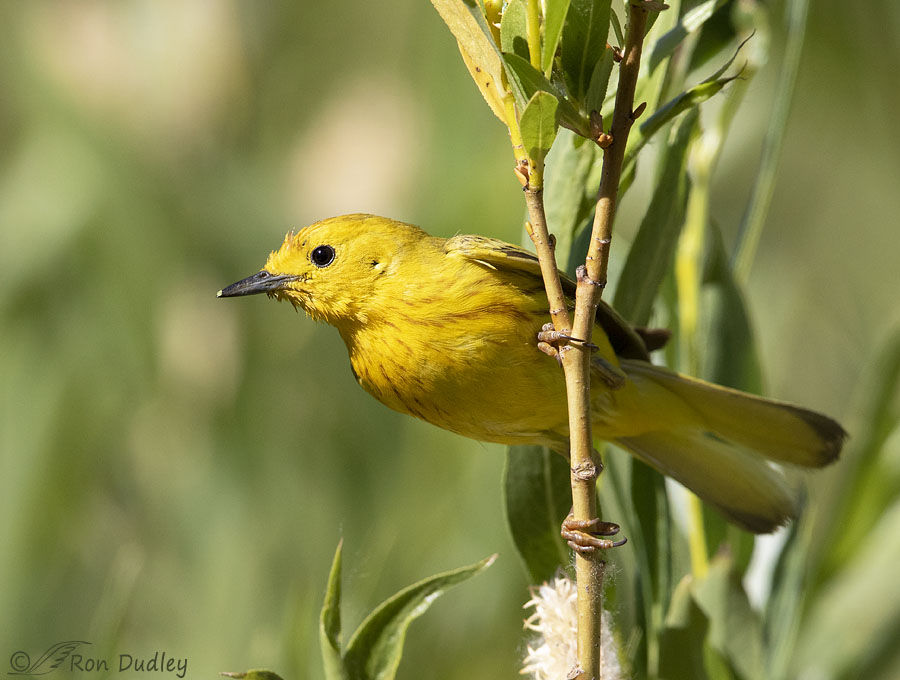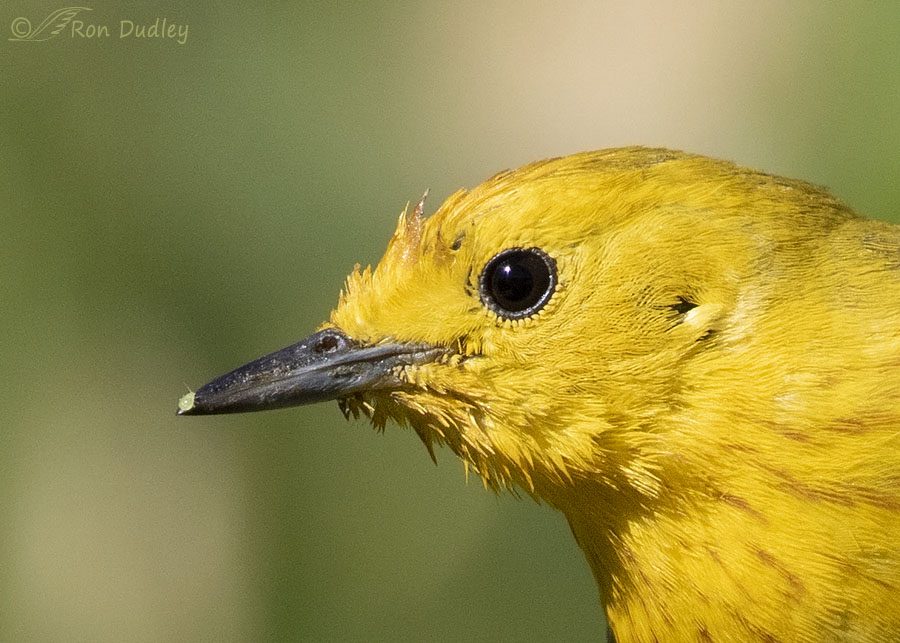I should review my older photos more often. And more carefully.
I’m resigned to staying isolated and staying home over this holiday weekend so yesterday I spent some time catching up on my image-culling backlog. During the process I ran across some two year old photos of a male Yellow Warbler that caught my attention.

1/3200, f/6.3, ISO 800, Canon 7D Mark II, Canon EF 500mm f/4L IS II USM + EF 1.4 III Extender, not baited, set up or called in
I photographed him in the Wasatch Mountains on July 1, 2018. He and his mate had three hungry fledglings that they were trying to keep well fed and happy so both adults looked like they’d been through the proverbial ringer. The effort of raising their family combined with the possible effects of molt gave both adults an unkempt look.
When I took this photo and others like it I noticed ‘something’ on the tip of his upper mandible but it was tiny and light green so I presumed it was a bit of plant debris or something similar and didn’t gave it another thought.
Until yesterday when I realized that the photo was sharp so I might be able to identify the object on his bill with confidence if I cropped in real tight.

Lo and behold, it wasn’t plant debris after all. It was a fat and juicy (and very lucky, for the moment at least) aphid.
Aphids are only about 1/10″ long so I was lucky that the tip of the warbler’s bill was sharp enough to make a positive ID (this highly cropped version of the photo is only 5% of the original image, 1 MP of 20 MP). Here the typical pear-shape of aphids and even some of its tiny appendages are apparent.
I realize that being able to ID the aphid is likely no big deal to some (most?) viewers but its a reminder to me that my photo gear has sufficient resolution to potentially resolve many questions in my photos about anatomy, species identification and even behavior. As a biologist that’s important to me.
In the past I’ve often just assumed that such determinations were beyond my reach so I didn’t even make the attempt.
Ron
Happy Independence Day, despite the abomination at Mount Rushmore last night.
Please be careful and safe, today especially.


And you can even see its ear! Thanks for mentioning the detail about the warbler’s somewhat disheveled appearance due to molt (and being a parent). I would’ve guessed it had just taken a drink of water and it was now drying itself.
I am delighted to have stumbled upon this blog. I had googled blue heron taking flight when I came across your series. Loved it so much I kept kicking around and now am going through all of your recent posts. Of course, I signed up for your newsletter.
I like this close cropped picture for both the aphid and his little ear hole that is now prominent on the side of his head.
I am enjoying this site immensely. It is like I’m out there with you. Thanks for sharing.
Thanks very much Deb and welcome to Feathered Photography.
Happy Fourth to you.
Cool aphid find. I like insect photos. It gives me a chance to see them up close.
Thanks, Deedee. I like them too, especially when they’re unexpected.
Happy July 4th! I have been following you for years until all of the political comments started appearing. I know it is no lose if 1 fan decides to stop following but politics is everywhere and I choose to follow sites that keep their politics to themselves. But since it has been part of the conversation here, how do you think people feel who don’t agree with you. Last night with the President was awe inspiring. He said all the right things. Before long this country is going to be worse off than it is now. The biological weapon used will be the stronger than the version we see now. Every attempt will be made to get rid of the President before election even though they failed at the last 4 attempts. Nothing will hold them back. Open your eyes. Investigate. It is all written out in back and white. How will Biden work out for you? Just an empty puppet with Marxist’s strings. Enjoy and goodbye. God Bless America and President Trump.
Debbie,
Last time I checked this is my blog, not yours. I’ll post what I choose to. Forgive me if I forget to ask for your prior permission.
Sayonara.
I am not in the slightest bit surprised that you find gems in your fortunately not discarded but not published piles.
You NEED a secretarial team – and have some very willing volunteers hanging in the wings.
And yes, as usual, I echo Laura. There aren’t sufficient superlatives.
“You NEED a secretarial team”
That would be great in some ways, EC. The problem is that not even I know which photos to keep and which to ditch in many cases. It would be an impossible task for anyone else.
I absolutely love seeing the ventral surface of this warbler! I’ve thought for a long time that the tail feathers had more grey throughout. I get excited when I’m able to correct a science-related misconception!
There are 4 stone presidents who are crying today.
“I get excited when I’m able to correct a science-related misconception!”
Just one of the many values of good photos, Marty. I’ve had many of my misconceptions corrected too.
Great photo. They do glean insects from plant surfaces so it makes sense one go stuck. But it does make me wonder….
There is a population of Townsend’s Warblers that winters in the mountains of Mexico. While there, they seek out aphids, but not to eat the aphid. Aphids are so tiny they pierce only one plant cell at a time. When they poke into the cell, the cell’s internal pressure forces some of its contents into the aphid. That forces a droplet out of the aphid’s rear end. It is called honeydew because it is sweet. The Townsend’s Warblers carefully consume this honeydew without harming the aphid, allowing the aphid to produce more. I know that Yellow Warblers consume aphids, but this photo makes me wonder if they have found the trick of taking honeydew as well. I’ve seen no reports of them consuming honeydew, like the Townsend’s Warblers do, but this makes me wonder.
So, Townsend’s Warblers are known to use aphids much like some ants do. Interesting.
You always provide some fascinating tidbits, Dan. Thanks for that.
Wow! I had no idea that any birds “milked” aphids. Amazing! Thank you for the coolamatious fact of the day, Dan! 🙂
Oh just WOW! Not to be ridiculously redundant again, but you just FORCE me into that behavior! What’s really needed here is about 100 new superlatives. Maybe I’ll make some up this weekend while taking social distancing to a whole ‘nother level, hanging out with my dogs, the hawks and my homey germs that know me and haven’t yet tried to kill me! 😉
ANYWAY, what a gorgeous little guy! He makes me think of aspens in the fall in Wyoming. They just scream “YELLOW!! Ain’t I BEAUTIFUL?!” The aphid is a HUGE bonus! Even his disheveled appearance is splendidly gorgeous! Parental responsibilities paired with the realities of molting–you might think I’m crazy (and you’re probably right about that) but I find that beautiful, too! There’s a simple elegance in survival. It’s hard, honest work and that’s good.
Yes, if this is an example of an almost cull, PLEASE look more carefully. Consider it a first draft of a letter. When you go through a second time, you inevitably find those pesky hidden (invisible) typos and better ways of saying what you need to say!
Finally, do not, I repeat DO NOT get me started about the debacle at Mount Rushmore! We don’t want to set your blog on fire, do we? 😉
Laura, typically I proofread my posts 10-12 times before I publish and I often still find typos and other errors hours after I’ve published. Or readers find them and point them out to me, which I appreciate.
So your point is well taken about checking carefully before I cull an image.
That is incredible you can zoom in and see the detail of the aphid. Did you know aphids give live birth? It is amazing to watch how many.
Yes, I used to teach my classes about viviparous, oviparous and ovoviviparous organisms. I would often use aphids as surprising examples of insects that are viviparous (live birth).
Unbelievable amount of detail for that huge crop. You must be tickled to have such an amazing lens. I know I am.
So, can one assume that you are two years behind on your culling? Since you’re staying put for the weekend it shouldn’t be a problem to get up to date.😀
Lyle, I’m especially tickled because with my new teleconverter I have my old sharpness back. Not knowing my old one was defective gave me hit or miss sharpness and that was pretty damned depressing.
About 2 years ago I began to get behind on my culling and until a couple of months ago I wasn’t doing it regularly. So yes, I have a huge backlog of what I estimate to be 100,000 photos to cull.
It’s intimidating as hell.
I’ll bet that the warbler was just saving the aphid for the next begging fledgeling? Heck, that’s what I would do. The next yell for food gets the tasty snack. Wonderful picture Ron! Happy 4th everyone 🙂
You may be right, Rick. There’s no doubt that he knew it was there.
What a beautiful bird. The aphid is the cherry on top! Thanks once again for brightening my day!
A green cherry but still a cherry. Thanks, Diane.
Ron, one of the things I enjoy most about my pics of flowers, butterflies, etc., is finding little creatures that I didn’t know I’d photographed. My most recent was of a dragonfly, which when I put it on my monitor revealed a winged termite at the tip of the dragonfly’s roosting spot. Makes life even more fun!
It sure does, Tony. Going through my images is a little like a treasure hunt and occasionally I even find the treasure.
That resolution is remarkable. Great photo Ron and always nice to see Yellow Warblers.
Happy 244th anniversary of our Declaration of Independence from King George III.
Thanks, Everett. Same to you.
The aphid IS a big deal and I can see it would be easy to miss as first glance when going through photos – particularly the volume you have……. 😉 They are beautiful (and hard to capture) little birds! 🙂 Last week I watched one work to get a LARGE spider web out of a spruce tree – for a nest I presume. Took awhile but he “got it”. Happy Independence day and YES, it’s a “stay at home day” while some ignorant (or give a shit) folks have at it! 🙁
Judy, I’d have loved to be able to photograph your warbler collecting spider silk for its nest.